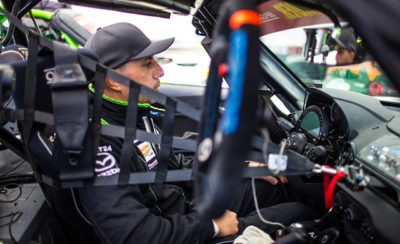Seating position is critical, but sometimes it’s going to be a compromise
In the first story on seating position, MazdaMotorsports.com presented some expert opinions on why seating position is important for racers, time trial participants and autocrossers, how to get everything in the right alignment, and also why Mazda OEM engineers work so hard on what they call “Human Centricity,” in which they focus on every aspect of a driver’s physical connection with the car. In the second part of this series, we present more thoughts on the matter, and discuss those times when you’re sharing a car and need to make compromises.
In that first installment, Mazda racer and coach Tom Long expounded on how to get the correct seating position for control and safety. There are a few other things to consider as a driver arrives at the correct arrangement:
Pedals: It’s not just important to reach the pedals; you need to be able to run them through their full range of motion. “You need to be able to push the clutch all the way in,” says racer and coach Joel Miller. “I see it a lot of times where people reach for the clutch and they get halfway down. Same with the brakes. In a lot of the coaching I do, some students have no idea how hard they have to press on the pedals so they don’t sit close enough, and when they do need to press on the pedals hard, they are out of throw. I work on the legs and making sure we can get all the pedals. From there we work on the back of the seat.”
Rake: Rake is how far the back of the seat is angled. For some, especially drivers with shorter legs or long arms, it may be a necessary tool to get the feet and hand placements right. For others, it’s a matter of preference and can also be a safety factor. “I personally like a seat that’s very raked back; I feel it holds me in the seat better and I feel like I can feel things with the butt a lot more,” says Idemitsu Mazda MX-5 Cup racer Drake Kemper.
Adds Miller: “You usually want a bit of recline. The reason for that is when you hit the brakes, you don’t want to submarine – slide under the steering wheel. So you need under the butt tilted a little bit more so when you hit the brakes, you’re actually forcing yourself into the seat versus forcing yourself into the sub belt.” That can be key especially for anyone autocrossing or tracking a car that has OEM seat and seatbelts vs. racing harnesses.
Sharing: If you’re competing in endurance races, swapping drivers during an autocross, or just otherwise sharing a car, there’s probably going to be some compromises in seat placement. With stock seats and belts, the range of adjustment in seat and wheel make it much easier. With a fixed racing seat, though, it becomes a challenging task.
Harry Tincknell is fortunate that, at 6-foot 1-inch, he’s usually the tallest driver in the No. 55 Mazda RT24-P. That means he sets the seat for himself, and the other drivers are molding inserts to make the seat fit them.
“As an endurance driver, it’s a team effort and it’s all about the car going as quick as possible, so everything has to be a compromise whether it’s setup or seating position,” Tincknell explains. “I make the base seat because I’m generally the tallest driver in the car, and then from that base seat the smaller guys will make an insert to fit. You have to compromise to find a position where everyone’s comfortable, but everyone still has enough support. There are other tricks you can do – we have an air pump to add some support.”
Another option, if the rules allow it, are seat sliders specifically made for racing. Not every sanctioning body permits them, though, so check the rules before you decide to use one.


 ACCESSIBILITY
ACCESSIBILITY